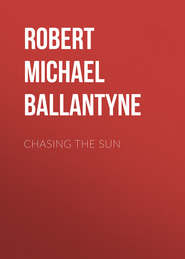По всем вопросам обращайтесь на: info@litportal.ru
(©) 2003-2025.
✖
Man on the Ocean: A Book about Boats and Ships
Год написания книги
2019
Настройки чтения
Размер шрифта
Высота строк
Поля
The log, to which we have referred, is the instrument by which is determined the rate at which a ship is progressing. It is a very simple contrivance: a triangular piece of wood about the size of a large saucer, with a piece of stout cord fastened to each corner, the ends of the cords being tied together, so that when held up, the “log,” as it is called, resembles one of a pair of scales. One of the cords, however, is only temporarily attached to its corner by means of a peg, which when violently pulled comes out. One edge of the triangle is loaded with lead. The whole machine is fastened to the “log-line,”—a stout cord many fathoms long, which is wound on a large reel.
“Heaving the log,” as we have said, takes place every hour. One sailor stands by with a sand-glass which runs exactly half a minute. Another holds the wooden reel; and a third heaves the log overboard, and “pays out” line as fast as he can make the reel spin. The instant it is thrown the first sailor turns the sand-glass. The log, being loaded on one side, floats perpendicularly in the water, remaining stationary of course; while the man who hove it watches sundry knots on the line as they pass over the stern of the ship, each knot representing a mile of rate of speed in the hour. As the last grain of sand drops to the bottom of the glass the first sailor gives a sharp signal, and the second clutches and checks the line, examines the knot nearest his hand, and thus knows at once how many knots or miles the ship is sailing at that time. The sudden stoppage of the line jerks the peg, before referred to, out of the log, thereby allowing the other two fixed cords to drag it flat and unresisting over the surface of the sea, when the line is reeled up and put by. The flight of another hour calls for a repetition of the heaving of the log.
As scientific knowledge advanced, instruments of peculiar and more complicated form were devised to enable navigators to ascertain more correctly their position on the surface of the sea; but they did not, and never will, supersede the method by dead-reckoning—for this reason, that the latter can be practised at all times, while the former are useless unless the sun, moon, or stars be visible, which in some latitudes they are not for many days and weeks, when clouds and fogs shroud the bright sky from view.
The Quadrant is the chief of those instruments. It is represented on next page. To give a succinct account of this would take up more space than we can spare. It may suffice the general reader to say that by observing the exact position of the sun at noon, or of the moon or a star, in relation to the horizon, the precise latitude of a ship—that is, her distance north or south of the equator—is ascertained. The method of “taking an observation” is complicated, and difficult to explain and understand. We refer those who are curious on the point to treatises on navigation.
Chronometers are exceedingly delicate and perfect time-keepers, or watches, which are very carefully set at the commencement of a voyage. Thus the time at the meridian whence a vessel starts is kept up during the voyage. By means of an observation of the sun with the quadrant, or sextant (a somewhat similar instrument), the true time at any particular point in the voyage may be ascertained. A difference is found to exist between the time at the spot where the observation is taken, and the time of the chronometer. A calculation founded on this difference gives the ship’s longitude—that is, her distance east or west of the meridian that passes through Greenwich. That meridian is an imaginary line drawn round the world longitudinally, and passing through the north and south poles, as the equator is a line passing round it latitudinally.
When a ship’s latitude and longitude have been ascertained, and a line drawn through the first parallel to the equator, and another line through the second parallel to the first meridian, the point where these two lines intersect is the exact position of the ship upon the sea.
The size and form of ships having gradually improved, the compass and other scientific appliances having been discovered, cannon also and gunpowder having been invented, seamen became more courageous and venturesome; and at last the Portuguese nation began that career of maritime enterprise which won for it the admiration of the world.
About the beginning of the fourteenth century (1330), the Canary Islands, lying off the west coast of Africa, were re-discovered by the accident of a French ship being blown off the coast in a storm, and finding shelter amongst them. This group had been known to the ancients under the name of the Fortunate Islands, but had been forgotten for more than a thousand years. During the course of the century the Spaniards plucked up courage to make discoveries and settlements upon them, although by so doing they were compelled to undergo that much-dreaded ordeal—sailing out of sight of their once fondly “hugged” land!
In the beginning of the next century arose a prince, Don Henry, son of John the First of Portugal, whose anxiety to promote discovery, and to find a passage by sea round the coast of Africa to India, induced him to send out many expeditions, all of which accomplished something, and many of which added very extensively to the geographical knowledge of the world at that time. Navigators, sent out by him from time to time, discovered the Madeira Islands; sailed along the western coast of Africa a considerable distance; ascertained the presence of gold-dust among the savages on the Gulf of Guinea; discovered the Azores, besides numerous other islands and lands; crossed the equator, and approached to within about eighteen hundred miles of the south-most cape of Africa.
The discovery of gold-dust stirred up the energies of the Portuguese in a remarkable degree, and caused them cheerfully to undertake ventures which, without that inducement, they would probably never have undertaken at all. Moreover, they had now learned to quail less at the idea of losing sight of land; and towards the end of the fifteenth century (1486), Bartholomew Diaz, an officer of the household of John the Second, achieved the grand object which had long been ardently desired by the Portuguese—he doubled the great southern cape of Africa, which King John named the “Cape of Good Hope,” although Diaz had named it the “Cape of Tempests.” The circumstance is thus alluded to by a poet of that period—
“At Lisboa’s court they told their dread escape,
And from her raging tempests named the Cape.
‘Thou southmost point,’ the joyful king exclaimed,
‘Cape of Good Hope be thou for ever named!’”
Chapter Six.
Boats, Model-Boat Making, etcetera
Leaving the subject of ancient ships and navigation, we shall now turn our attention to the more recent doings of man on the ocean, and, before entering into the details of ships and ship-building, devote a little time and space to the consideration of boats.
There are great varieties of boats—as regards shape, size, material, and use—so that it is not easy to decide on which we shall first fix our attention. There are large and small, long and short boats; flat, round, sharp, and bluff ones,—some clumsy, others elegant. Certain boats are built for carrying cargo, others for purposes of war. Some are meant for sailing, some for rowing; and while many kinds are devoted to business, others are intended solely for pleasure. Before we refer to any of these, perhaps our young readers will not object to be told how to construct:—
A Model Boat
We need scarcely say that it is not expedient for a boy to attempt to build a model boat in the same manner as a regular boat-builder constructs one for actual service. It would be undertaking an unnecessary amount of labour to lay a keel and form ribs and nail on planks in the orthodox fashion, because, for all practical purposes, a boat cut out of a solid block of wood is quite as useful, and much more easily made.
The first thing you have to do, my young boat-builder, then, is to go and visit a harbour or beach where varieties of boats are to be found, and, having settled in your mind which of them you intend to copy, make a careful drawing, in outline, of its form in four different positions. First, a side view, as in Figure 1. Then the stern, with the swelling sides of the boat visible, as in Figure 2. The bow, as in Figure 3; and a bird’s-eye view, as in Figure 4. The last drawing can be made by mounting on some neighbouring eminence, such as a bank or a larger boat, or, if that is impossible, by getting upon the stern of the boat itself, and thus looking down on it. These four drawings will be of great service in enabling you to shape your model correctly; for as you proceed with the carving you can, by holding the model up in the same position with any of the drawings, ascertain whether you are progressing properly; and if you get the correct form of your boat in these four positions, you will be almost certain to make a good boat. If, on the other hand, you go to work without drawings, the probability is that your boat will be lopsided, which will prevent it from floating evenly; or crooked, which will tend to check its speed in sailing, besides being clumsy and not “ship-shape,” as the sailors have it.











